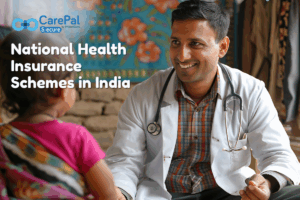Government Health Insurance Schemes: Best Plans for Your Family’s Future

India’s healthcare system has undergone significant transformations, prompting central and state governments to come up with a plethora of health insurance schemes. Some initiatives target the middle-class population, while many programs address economically disadvantaged populations. This blog features information on helpful schemes for middle-class families.
Health Insurance Schemes by Central Government
a. Ayushman Bharat–Pradhan Mantri Jan Arogya Yojana (PM-JAY)
First launched in 2018, Ayushman Bharat is often described as the world’s largest government-supported healthcare scheme. The scheme, which was conceived to offer health coverage to the poorest 50% of India’s population, provides coverage of ₹5 lakh per family per annum for secondary and tertiary care hospitalization. In September 2024, the government expanded this program to citizens aged 70 and above—regardless of the economic situation—adding some 60 million beneficiaries.
Key Features:
Extensive Coverage: The plan has a coverage of more than 1400 medical procedures and also includes pre and post hospitalization expenses.
Cashless and Paperless: Beneficiaries can receive cashless treatment in listed public and private hospitals across the country.
Portability: The benefits are portable across the entire India as it allows the beneficiaries to get the services in any state.
Middle-Class Eligibility:
Though it still focuses on economically weaker sections, the inclusion now extends to senior citizens who are 70 and above, irrespective of income, giving major relief to middle-class households in terms of elderly healthcare expenses. This scheme is particularly important for you in case you have old parents. The rates for the procedures are negotiated by the central government and therefore 5 lacs of cover under Ayushman Bharat might actually be equivalent to 15 lac of normal health insurance cover. One problem with this scheme is that many hospitals have raised concerns about payments delay and therefore admission process is not very smooth.
b. Employees State Insurance Scheme (ESIS)
The ESIS is a self-financed social security and health insurance for Indian employees. It serves employees with a monthly salary of ₹21,000 or less and offers extensive medical care to insured individuals and their dependents. This is a great basic health insurance cover for the lower middle-class households.
Key Features:
Therapeutic Medical Treatment: Encompasses both outpatient and inpatient procedures, such as specialist consultations and hospitalization.
Dependents’ Benefit: A benefit which extends to medical benefits for dependents of an insured person. Not only wife and children but dependent parents with an income of below 9000 per month are covered under ESIS.
Cash Benefits: Provides cash benefits for certified sick and maternity leaves.
For Middle-Class Individuals Who Are Eligible:
Employees whose salary falls under specified wage limit can avail ESIS benefits (middle class employees). Some states allow employers to opt to pay benefits to workers earning over the wage limit.
Health Insurance Schemes of State Government
There are several health insurance schemes launched by the state governments for the residents of the state, including middle-class people. Here are a few notable ones:
a. Mahatma Jyotirao Phule Jan Arogya Yojana (MJPJAY)–Maharashtra
MJPJAY was aimed at ensuring that families in Maharashtra can access high-quality, subsidized medical care. Originally aimed at economically weaker sections, the scheme has since been expanded to cover many other segments in various categories.
Key Features:
Coverage Amount — Covers expenses up to ₹1.5 lacs per family per year for listed procedures.
Services in Empaneled Hospitals: Beneficiaries can get service in the empaneled public or private hospitals of the state.
Eligible: middle class
Initially targeted at low-income families, the scheme now covers all families in the state, offering up to ₹1.5 lacs under MJPJAY and ₹5 lacs under Ayushman Bharat annually. From 1st July 2024, it ensures comprehensive, cashless healthcare for the entire population of Maharashtra.
Beneficiary category under MJPJAY
Category A: Families holding Yellow, Antyodaya Anna Yojana (AAY), Annapurna Yojna and Orange Ration Card.
Category B
White ration card holder families (including Govt./Semi Govt. employees).
A family having no kind of ration card but having domicile certificate of Maharashtra.
Category C
Students in Govt. and Govt. recognized Ashram School.
-
Children in Govt. and Govt. recognized Orphanages.
Women in Govt. and Govt. recognized Women’s Ashram.
Sr. citizens in Govt. and Govt. recognized old age homes.
Journalists and their dependent family members as per criteria of Directorate General of Information and Public Relations Office.
Construction workers and their families (who are resident of outside of Maharashtra) registered with Maharashtra Building and Other Construction Workers Board.
Category D: Road traffic accident victims from outside Maharashtra and outside India who met with an accident on roads in Maharashtra
Category E: Families holding below mentioned ration cards from 865 villages of Belgaon, Karwar, Kalburgi and Bidar Districts of Maharashtra- Karnataka border
Antyodaya Anna Yojana (AAY)
Priority House Holder (PHH)
Annapurna Yojna \
Arogya Karnataka–Karnataka State Govt
The Arogya Karnataka Scheme is a program launched by the Government of Karnataka to provide universal health care coverage to all the residents of Karnataka. It encompasses a range of medical services, such as primary, specialized secondary, and tertiary care, to ensure that necessary medical attention is provided to all individuals without financial burden. Arogya Karnataka Scheme is a comprehensive health scheme that merges several other healthcare schemes, such as Vajpayee Arogyashree, Yeshaswini Scheme, Rajiv Arogya Bhagya Scheme, etc.
Advantages of the Arogya Karnataka Scheme:
Coverage of Financial for Eligible Households: Eligible Households as per National Food Security Act, 2013 or the families whose name is there in Socio-Economic and Caste Census (SECC) and the family can avail cashless treatment up to ₹5,00,000 per family per year. This covers prescribed secondary, tertiary, complex secondary and emergency healthcare services.
General Patients Coverage: 30% of the government package rates — that is applicable for all residents of Karnataka, not a part of the ‘Eligible Household’, and having Above Poverty Line (APL) ration cards will be covered up to a maximum of ₹1,50,000 per family per year.
Program Fee: The applicants can obtain the Ayushman Karnataka card after submitting an entry line of ₹10. This is the id proof to avail of the benefits of the scheme. citeturn0search2
Eligibility Criteria:
For Eligible Patients:
She/he has to be a resident of Karnataka
Must be a part of an ‘Eligible Household’ as defined by the National Food Security Act, 2013, which also includes the Below Poverty Line (BPL) ration card holders
-
People included in the SECC data
Members who are already enrolled in existing Rashtriya Swasthya Bhima Yojana (RSBY)
For General Patients
Should be domiciled in Karnataka.
As per the National Food Security Act, 2013, should not be part of the ‘Eligible Household’.
Should have APL (Above poverty line) ration card.
Enrollment Process:
Registration is done using the Aadhaar Card number of the person. Biometric data of the patient is captured and authenticated with the Aadhaar server. If biometric authentication is not possible, one can verify through a one-time password (OTP) or fetching data from the Food Department’s database. Enrollments centers are KC General Hospital, Bangalore, Sri Jayadeva Institute of Cardiovascular Science & Research, among other major hospitals in Karnataka.
Understanding even the variety of Health Insurance policies offered in India can be cumbersome. However, to make informed decisions, middle-class families need to learn about their specific needs, as well as the features of both central and state government schemes. Also, promote family health insurance for parents to ensure that everything is covered. Individuals should carefully evaluate their needs relative to what’s available, choosing a plan that provides the best.
Conclusion:
Secure is designed to provide you and your family with comprehensive, accessible, and affordable healthcare solutions. Whether you’re an individual, a family, or a senior citizen, there’s a plan designed to provide financial security and peace of mind.
Some key reasons why you should choose CarePal Secure are:
Extensive Coverage: Get access to a wide network of hospitals for cashless treatments, covering everything from regular health check-ups to major hospitalisations.
No Waiting Period for Essential Coverage: CarePal Secure offers immediate access to essential healthcare benefits so that yCarePal ou can receive critical medical treatment without long approval delays.
24/7 Medical Assistance & Claims Support: Our dedicated helpdesk is available round-the-clock to assist you with medical emergencies, claim processing, and consultation bookings.
Teleconsultations & Healthcare Discounts: Our seamless teleconsultation services allow you to access specialists across 18+ medical fields. Additionally, you can enjoy significant savings on medicines, diagnostic tests, and outpatient care, making quality healthcare more affordable.
Affordable Plans with Super Top-Up Options: Choose from a range of budget-friendly plans for individuals, families, and seniors. Our super top-up policy for seniors provides additional financial protection, covering larger medical expenses at a lower cost.
Tax Benefits Under Section 80D: The premiums paid toward CarePal Secure health insurance are tax-deductible, helping you save money while ensuring comprehensive coverage for yourself and your family.
With trusted partners nationwide, CarePal Secure ensures that quality healthcare is always within reach. So what are you waiting for? Join 80,000+ satisfied customers who trust CarePal Secure for their healthcare needs.
Get in touch with us to know the right plan for you
Frequently Asked Questions
Ayushman Bharat (PM-JAY) is one of the best government health insurance schemes, offering up to ₹5 lakh coverage per family per year.
Mediclaim policies offer financial protection against hospitalization, surgeries, and treatment costs, ensuring peace of mind during medical emergencies.
You can apply through official government portals, local health departments, or Common Service Centres (CSCs) by providing necessary documents and eligibility proof.
Most government schemes have minimal or no waiting period for pre-existing diseases, unlike private policies which often have a waiting period of 2–4 years.
Government plans are subsidized and offer basic coverage to economically weaker sections, while private plans provide more customization, wider coverage, and faster claim processing.

Pankaj Nawani is an accomplished insurance professional with over 20 years of industry experience. His journey has reinforced two key beliefs: that insurance is a powerful force for good and that India needs significantly more of it. Passionate about transforming the sector, Pankaj is on a mission to redefine insurance for India, focusing on innovation across products, sales, and servicing. He collaborates with visionary entrepreneurs, founders, and investors to bring this vision to life.












